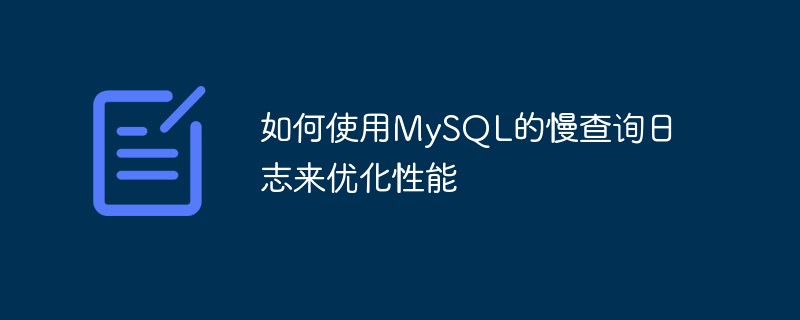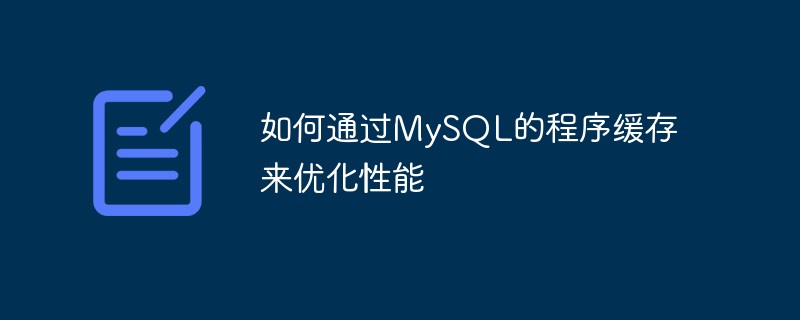
Coroutine synchronization and performance optimization in Golang
Introduction:
Golang (Go programming language) is a concurrent programming language developed by Google. Its concurrency feature is one of its biggest highlights, especially through the goroutine mechanism, which can easily achieve efficient concurrent operations. However, coroutine synchronization and performance optimization are one of the issues that need to be focused on during the development process of Golang. This article will introduce in detail the common methods of coroutine synchronization in Golang, and show how to optimize the performance of coroutines through specific code examples.
1. Common methods of coroutine synchronization
- Channel: Channel is an important mechanism in Golang for communication and synchronization between coroutines. By passing data between coroutines, synchronous execution of coroutines can be achieved. For example, channels can be used to implement the function of waiting for one or more coroutines to complete before continuing execution. The following is a sample code for coroutine synchronization through channels:
func main() {
ch := make(chan int)
go doSomething(ch)
result := <- ch
fmt.Println("协程执行结果:", result)
}
func doSomething(ch chan int) {
// 协程执行代码
time.Sleep(time.Second)
// 向通道发送结果
ch <- 100
}In the above example, a channel ch is created through the make() function, and then the doSomething() function is executed in a coroutine , and pass channel ch as a parameter. In the doSomething() function, a time-consuming operation is simulated through the time.Sleep() function, and then the result is sent to the main coroutine through the channel. Finally, the main coroutine receives the result from the channel through the
- WaitGroup: WaitGroup is another coroutine synchronization mechanism in Golang that can wait for coroutines to end before they are executed. The following is a sample code that uses WaitGroup to implement coroutine synchronization:
func main() {
var wg sync.WaitGroup
wg.Add(2)
go doSomething(&wg)
go doSomething(&wg)
wg.Wait()
fmt.Println("所有协程执行完成")
}
func doSomething(wg *sync.WaitGroup) {
defer wg.Done()
// 协程执行代码
time.Sleep(time.Second)
}In the above example, first set the number of coroutines to wait through the Add() method of sync.WaitGroup. Then, before executing the doSomething() function in each coroutine, the count is decremented by 1 through wg.Done(). Finally, wait for all coroutine execution to complete through wg.Wait(). When all coroutines are completed, the main coroutine will continue to execute and print out "All coroutines have been executed."
2. Coroutine performance optimization
Performance optimization of coroutine is an important part of Golang development, which can greatly improve the execution efficiency of the program. The following will introduce how to optimize the performance of coroutines from the following two aspects.
- Quantity control of coroutines: When using coroutines, you need to pay attention to the number control of coroutines. Opening too many coroutines may cause a waste of system resources and may affect program performance. Therefore, the number of coroutines needs to be reasonably controlled based on actual needs. When using channels for coroutine synchronization, you can use channels with buffers to limit the number of concurrent coroutines. For example, the following code shows how to use a channel with a buffer to control the number of coroutines:
func main() {
ch := make(chan int, 10) // 设置通道缓冲区大小
for i := 0; i < 10; i++ {
ch <- i // 将任务发送到通道中
go doSomething(ch)
}
time.Sleep(time.Second)
close(ch)
}
func doSomething(ch chan int) {
for i := range ch {
// 协程执行代码
time.Sleep(time.Second)
fmt.Println("协程", i, "执行完成")
}
}In the above example, by adjusting the buffer size of channel ch, you can control the allowed concurrent coroutines quantity. Multiple tasks are sent to the channel through a loop in the main coroutine, and the doSomething() function is executed through the coroutine. In the doSomething() function, traverse the tasks in the channel through the range and perform the corresponding operations. When the channel is closed, the coroutine ends execution. In this way, the number of concurrent coroutines can be limited to improve the performance of the program.
- Use thread pool (goroutine pool): Thread pool is a common concurrency optimization technology that can reuse already created threads or coroutines to avoid frequent creation and destruction of threads. In Golang, the thread pool function can be implemented through sync.Pool. The following is a sample code that uses a thread pool to optimize coroutines:
func main() {
pool := &sync.Pool{
New: func() interface{} {
return make([]int, 20)
},
}
for i := 0; i < 10; i++ {
go doSomething(pool)
}
time.Sleep(time.Second)
}
func doSomething(pool *sync.Pool) {
data := pool.Get().([]int)
defer pool.Put(data)
// 使用数据进行处理
// ...
time.Sleep(time.Second)
fmt.Println("协程执行完成")
}In the above example, a thread pool is first created through sync.Pool, and the objects in the thread pool are initialized using the New method. . In the doSomething() function, obtain an available object from the thread pool through pool.Get(), and use pool.Put() to put the object back into the pool after processing the data. In this way, the overhead of frequently creating and destroying coroutines can be reduced and the performance of the program can be improved.
Summary:
This article introduces in detail the common methods of coroutine synchronization in Golang, including channels and WaitGroup. The sample code demonstrates how to use these mechanisms to implement synchronous execution of coroutines. At the same time, performance optimization methods for coroutines are proposed, including controlling the number of coroutines and using thread pools. By properly controlling the number of coroutines and using thread pools, you can improve program performance and improve system responsiveness. In actual Golang development, it is necessary to choose the appropriate coroutine synchronization method and performance optimization method according to the specific situation to achieve efficient concurrent operations.
The above is the detailed content of Coroutine synchronization and performance optimization in Golang. For more information, please follow other related articles on the PHP Chinese website!
 深入了解content-visibility属性,聊聊怎么用它优化渲染性能Jul 18, 2022 am 11:19 AM
深入了解content-visibility属性,聊聊怎么用它优化渲染性能Jul 18, 2022 am 11:19 AM本篇文章带大家了解一下CSS content-visibility属性,聊聊使用该属性怎么优化渲染性能,希望对大家有所帮助!
 如何通过取消MySQL自动提交来提高性能May 11, 2023 am 08:15 AM
如何通过取消MySQL自动提交来提高性能May 11, 2023 am 08:15 AMMySQL是一种流行的关系型数据库管理系统,旨在提供高效、可靠、灵活的数据存储和处理方案。然而,MySQL在自动提交事务方面存在一些缺点,这可能会降低其性能。在这篇文章中,我们将介绍如何通过取消MySQL自动提交来提高其性能。一、什么是MySQL自动提交?MySQL自动提交是指对于任何一条SQL语句,默认情况下都会自动开启一个事务,并在执行完该语句后立即提交
 如何通过MySQL对DISTINCT优化来提高性能May 11, 2023 am 08:12 AM
如何通过MySQL对DISTINCT优化来提高性能May 11, 2023 am 08:12 AMMySQL是目前应用广泛的关系型数据库之一。在大数据量存储与查询中,优化数据库性能是至关重要的。其中,DISTINCT是常用的去重查询操作符。本文将介绍如何通过MySQL对DISTINCT优化来提高数据库查询性能。一、DISTINCT的原理及缺点DISTINCT关键字用于从查询结果中去除重复行。在大量数据的情况下,查询中可能存在多个重复值,导致输出数据冗余,
 PHP高性能:如何优化数据库查询Jun 04, 2023 am 08:40 AM
PHP高性能:如何优化数据库查询Jun 04, 2023 am 08:40 AM在当前互联网时代,随着数据的爆炸式增长,数据库成为了一个服务的核心。数据库的性能和速度更是直接影响了网站及其应用的用户体验和可用性,因此如何优化数据库查询是开发人员需要着重研究的一个问题。而在PHP语言中,通过对数据库查询语句的优化,可以提高程序的性能,减少服务器的负担,提高服务的稳定性。本文将从以下几个方面,介绍如何优化数据库查询:一、使用索引在进行查询时
 如何使用MySQL的慢查询日志来优化性能May 11, 2023 am 09:00 AM
如何使用MySQL的慢查询日志来优化性能May 11, 2023 am 09:00 AM随着数据量的增加和应用的复杂性,数据库的性能成为了一个越来越重要的问题。MySQL作为一款流行的关系型数据库管理系统,在优化性能方面也提供了许多工具和方法。其中,使用慢查询日志对MySQL进行性能优化是一种非常实用的方法。本文将介绍如何使用MySQL的慢查询日志来优化性能。一、什么是慢查询日志慢查询日志是MySQL中的一种日志记录机制,它会记录执行时间超过某
 通过使用MySQL查询缓存提高性能May 11, 2023 am 08:31 AM
通过使用MySQL查询缓存提高性能May 11, 2023 am 08:31 AM随着数据量的增加和访问量的增加,数据库的性能问题已经成为很多网站的瓶颈。在许多情况下,数据库查询是网站中最耗费资源的操作之一。MySQL作为一种开源的关系型数据库管理系统,已经成为许多网站的首选数据库。在MySQL中,查询缓存是一种可以显著提高查询性能的缓存机制。本文将介绍MySQL查询缓存的工作原理,并提供一些实用建议,可以帮助您更好地使用MySQL查询缓
 如何通过MySQL的程序缓存来优化性能May 11, 2023 am 09:40 AM
如何通过MySQL的程序缓存来优化性能May 11, 2023 am 09:40 AMMySQL是目前最流行的关系型数据库管理系统之一,被广泛应用于各种Web应用和企业级系统中。然而,随着应用规模的不断增大,数据库性能问题也成为了开发人员和系统管理员必须面对的挑战。其中,数据库查询是性能问题中的重点,因为它们通常是系统瓶颈所在。为了解决查询性能问题,MySQL提供了许多优化技巧和工具。其中一个重要的工具就是程序缓存(querycache),
 如何通过MySQL对UNION优化来提高性能May 11, 2023 pm 05:40 PM
如何通过MySQL对UNION优化来提高性能May 11, 2023 pm 05:40 PM在许多数据库应用程序中,我们都会面临需要整合来自多个数据源的数据的情况。MySQL的UNION语句就是一种用来解决这种情况的方式,它允许我们将两个或多个SELECT语句的结果集合并为一个。虽然这是一个非常方便的功能,但如果不加以优化,UNION语句也可能对系统产生性能问题。本文将探讨如何通过MySQL对UNION优化来提高性能。使用UNIONALL在使用U


Hot AI Tools

Undresser.AI Undress
AI-powered app for creating realistic nude photos

AI Clothes Remover
Online AI tool for removing clothes from photos.

Undress AI Tool
Undress images for free

Clothoff.io
AI clothes remover

AI Hentai Generator
Generate AI Hentai for free.

Hot Article

Hot Tools

Dreamweaver Mac version
Visual web development tools

MinGW - Minimalist GNU for Windows
This project is in the process of being migrated to osdn.net/projects/mingw, you can continue to follow us there. MinGW: A native Windows port of the GNU Compiler Collection (GCC), freely distributable import libraries and header files for building native Windows applications; includes extensions to the MSVC runtime to support C99 functionality. All MinGW software can run on 64-bit Windows platforms.

MantisBT
Mantis is an easy-to-deploy web-based defect tracking tool designed to aid in product defect tracking. It requires PHP, MySQL and a web server. Check out our demo and hosting services.

Atom editor mac version download
The most popular open source editor

Notepad++7.3.1
Easy-to-use and free code editor






